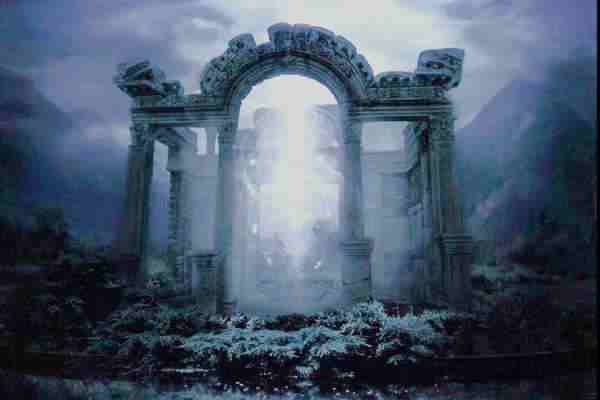The Hero’s Journey is a symbol of the mystical journey. What is the mystical journey? It is the inward journey of healing and self-development. It’s a quest exploring sacred spiritual journey experiences. Here, we gain sacred journey insights.
Our psyche is the ultimate frontier of exploration. Many ancient traditions sought ways to venture into the depths of consciousness. Joseph Campbell found a pattern for this quest in many ancient cultures. He calls this adventure the Hero’s Journey.
A quest is the search for something valuable. The inner quest is the search to find answers to the most important questions about life. These answers reside in the sacredness of our consciousness. This journey is about exploring sacred spiritual journey experiences and gaining enlightenment.
The Symbol of the Mystical Journey
The Hero’s Journey, as described by Joseph Campbell (1), is a pattern of spiritual growth where we gain sacred journey insights. It’s about going through tough times, making friends, facing challenges, and coming out stronger on the other side. It’s like a big, exciting, and sometimes scary rollercoaster ride everyone goes on in their own way. This pattern is in many stories from different places and times. Here are some examples.
— In the Chinese novel “Journey to the West,” the hero, Monkey King, helps a monk on a journey to bring back sacred journey insights. They meet friends and fight monsters along the way.
— In Greek mythology, the hero Odysseus goes on a journey to get home after fighting in the Trojan War. He faces many challenges, like a one-eyed giant named Cyclops and seductive sirens.
— In the African story of “Anansi the Spider,” Anansi goes on a quest to bring fire to the people. He faces tricky challenges and uses his cleverness to outsmart other animals.
— In the Australian Aboriginal story “The Rainbow Serpent,” a hero travels the land, learning how to use his special powers to help his people.
Gaining Sacred Journey Insights
The Hero Journey is the perfect symbol for the mystical journey. It’s a recipe for a great story. Writers and storytellers from every culture have used it to create epic tales of bravery and adventure. It’s a way to teach us about life, courage, and what it means to be a hero.
This cycle involves every aspect of our mind, body, and spirit. The inward journey of healing and self-development is a continual process.
We use the above quote from Joseph Campbell to start every new group. We encourage you to use this quote, and it is the spark igniting this journey for many spiritual explorers. No one can tell you what this mystical path holds for you. You’ll need to travel this journey to find out for yourself.
Mystics tell us the purpose of life is to create your own path, your mystical quest or journey. The problem is that religion confuses this quest with dogma. Organized Religion uses myth to replace the authentic spiritual journey. But the mystical quest is really about exploring consciousness. It has nothing to do with following a religion.
The Mystical Journey of Healing and Self-Development
The hero’s journey always begins with the call. ― Joseph Campbell
It is a cyclical process, starting with an awakening to the call to begin this inward journey of healing and self-development. As we embark on this quest and awaken, we begin the transformation process. (2) We open our spiritual gifts, which inspire us to share and help others. We awaken a little more, and the process starts over again.
The Hero’s Journey is a pattern at the heart of many spiritual traditions. Although they may have different characters, they contain many of the same core elements. The hero’s journey resonates with us because we are born to seek the unknown.
This pattern is not a religion. It’s the common structure of the spiritual path that takes us on an adventure to realize our full potential.
This universal pattern has three phases. If we look, we’ll also find this cyclical pattern in our own lives. Knowing where you are in this process is helpful. It’s a way of pinpointing the right actions to get you to the next phase in the cycle. This pattern repeats over and over, again and again. If you use a spiritual journal, you’ll find this pattern etched in the history of your life.
The inner quest is the call of the Universe whispering, seek me, let me show you the way. ― Guru Tua
Exploring Sacred Spiritual Journey Experiences
Many people are curious about the unknown. They seek answers about who and what they are. Why are we here? These questions are the impetus for exploring our consciousness, which brings us to the inner quest.
Teachers can provide you with tools, but you must find your own answers. Although the structure of our journey may have similar elements, the obstacles on the path are different for everyone. Here are some questions that may reveal roadblocks.
— What does the mystical journey mean to you?
— Is this quest only philosophical and theoretical, or is it as tangible and real?
— Do you see this journey as an adventure, or do you have reservations about it?
— Is your interest based on the need to fulfill religious obligations, or is it curiosity?
— Do you have some type of plan for your spiritual practice?
— Do you have friends who have the same interests?
You don’t need to join a religion to use processes for exploring consciousness. All you need to do is follow the steps in the procedure, and you get results. Organized Religion likes to assimilate everything that has a spiritual connotation. The same is true with the terms journey and quest.
The fact is, Organized Religion is not a mystical or spiritual quest. Religion is the belief in myths and superstition. The inner quest is about exploring consciousness, not pretending in the existence of an imaginary friend. So, those who follow a religion are not a symbol of the mystical journey but of religious hypnosis.
Let’s look at the three phases of the process, which involve exploring sacred spiritual journey experiences.
Three Phases of the Journey
This story has three main phases that intertwine and overlap. These phases are awakening, transforming, and inspiring. If we are perceptive, we can see these phases in our own lives. The Hero’s Journey is the inward journey of healing and self-development.
The Awakening
Awakening is a continual process of the hero’s journey. As long as you learn and grow, there will always be more to know. Awakening is the authentic symbol of the mystical journey.
Awakening starts when you ask, where would I be, or what would I be if I were not in this body? It’s when we question the fabric of their reality, stirring from the slumber of the mundane. The mind is open like a flower, curious about our existence. It’s a gentle nudge that whispers. There’s more to this existence than what you’ve been taught.
Awakening is all about learning to use the tools for investigating our consciousness. The tools are the common threads that build communities. Our path may be unique, but that doesn’t mean we need to walk alone. Using inner work tools, sharing, and learning from others is an essential part of growth and will provide experience.
Tools for the Inward Journey of Healing and Self-Development
There are many tools that help us in exploring sacred spiritual experiences. The Enneagram is one of the primary tools that teaches us about personality and instinct. It helps us understand that these are necessary tools of the Ego that connect consciousness to our bodies.
As we awaken, we learn practical tools, such as a journal or book of shadows. Journaling helps uncover incremental growth and opportunities for growth. Learning to apply analytical and logical tools helps us stay on track and avoid the common pitfalls of organized religion.
Sound and vibration are essential elements on the experiential side. Here, we recommend using the singing bowl and drum. Mantras are another vibrational tool that will help you meditate. Definitely explore forms of seated and moving meditation progressions. Add these tools to your spiritual toolbox.
The shamanic journey, lucid dreaming, and breathing techniques are all useful tools in the awakening process. These tools expand awareness. These exercises unveil our innate gifts and unique qualities. They enable us to become co-facilitators and help others to the next phase.
Transforming
The second step is akin to a caterpillar’s metamorphosis into a butterfly. As one awakens, we can shed the unhealthy beliefs and patterns of religion and commercialism. This phase is intense and often uncomfortable but necessary for healing and self-development. It’s where we deep dive into the well of consciousness, where we gain wisdom and sacred journey insights.
The weekend retreat format enhances exploring sacred spiritual journey experiences. It gives enough time to learn and share. Our transformation and personal illumination come as we overcome the obstacles on the path. Hence, we better understand ourselves and the universe as we employ more powerful tools. We enrich our learning as we walk alongside and help others.
Each technology in the learning sequence builds upon one another. The synergistic effect of learning these technologies provides an extraordinary experience. If you learn a process well enough to teach it to others, you’ve reached the transformation stage.
In this you add more advanced methods which include elements of the eightfold path of Yoga. These tools include Japa Meditation, and the Siddhis of Patanjali. Other moving methods include Qigong, Tai Chi, and Tai Kek.
Giving back includes helping others heal. Natural healing modalities like Reiki and Pejut are probably the hardest to teach with the virtual experience. If there are at least two participants at the location, we can make it work. Otherwise, they can do some techniques with a roller or Yoga block.
Preparation for Kundalini and third-eye activation are also part of this phase. The weekend event’s community-building aspect is a powerful part of the experience. It provides the foundation for the next stage. Learning these technologies and building a community is transformative. When you are experiencing positive growth, this, too, is a symbol of the mystical journey.
Inspiring
Inspiring others is a natural part of personal growth. Therefore, we become teachers of others and ourselves. As we learn more, we can assist others. We gain confidence in our path as we overcome obstacles or find ways around them.
This is the stage of giving back, of becoming a mentor or guide to those who are just starting their own awakenings. It’s about embodying the change and living in harmony. Each step builds upon the last, creating a beautiful tapestry of growth, enlightenment, and service to the world. When we are inspired, it leads to greater awareness and awakening. So, the cycle begins again.
The last phase is the inspiration of yourself and others. It is a natural evolution in the growth process. When we help and inspire others, we also grow. If we run into roadblocks, others will help and inspire us to break through them.
By this point, we have gained practical knowledge and experienced some level of transformation. Now, it is time to shift our focus to other people. To grow their knowledge, participants meet to share and help one another.
By inspiring and transforming others, they also learn a lot about themselves. This reveals new gifts. They learn to seek help and develop unique routines based on their special life situations. This leads to further awakening as we discover other aspects of our infinite nature.
In Conclusion
Exploring sacred spiritual journey experiences is an inward journey of healing and self-development. This quest fulfills the need for spiritual exploration, which religion cannot.
References
(1) The Hero with a Thousand Faces by Joseph Campbell. Wikipedia
(2) Spirituality and the Awakening Self by David G. Benner at muse project
Follow us on blogger



